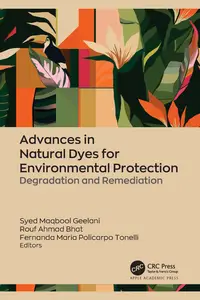
Free Download Advances in Natural Dyes for Environmental Protection
by Syed Maqbool Geelani, Rouf Ahmad Bhat, Fernanda Maria Policarpo Tonelli
English | 2025 | ISBN: 1774916568 | 335 pages | True PDF EPUB | 21.83 MB
Synthetic dyes, especially those used in the textile industry, are huge contributors to the damaging effects on ecosystems worldwide due to their toxic and non-biodegradable nature. Natural dyes, on the other hand, are interesting eco-friendly alternatives to synthetic ones. This new volume discusses the environmental pollution caused by dyes, presents advances in natural dyes, considers their advantages over synthetic dyes, and offers solutions to the difficulties related to the use of natural dyes. The volume also offers effective remediation strategies for the management of both natural and harmful synthetic dyes in the environment. Biotechnological tools and bioremediation strategies play a key role in dealing in eco-friendly manner with persistent pollutants such as dyes. This book discusses dyes derived from plant, animal, and microbial sources; conventional and non-conventional dyeing technology for textiles; and eco-friendly technology for dyeing processes. The book also goes into detail regarding the global market and challenges natural dyes face and why they are not being adopted on a large scale. The limitations of physical and chemical methods to treat polluted wastewater from dyes are also explored. Along the same line, the book proposes innovative management strategies and sustainable eco-friendly technologies to remediate dye pollution. This book details the holistic and multidisciplinary efforts being focused on trying to surpass the difficulties related to use of natural dyes while also addressing dye-pollution mitigation strategies. The book provides a plethora of useful information for academicians as well as researchers and students and industry professionals in the textile sector as well as in other manufacturing industries. Discusses the environmental pollution caused by dyes, presents advances in natural dyes, considers their advantages over synthetic dyes, and offers solutions to the difficulties related to the use of natural dyes. It also offers effective remediation strategies for the management of both natural and harmful synthetic dyes.
